World War II in Europe
huge area of heavy fighting across Europe
World War II or the Second World War took place over many continents: while the Pacific War took place in Asia and Oceania, the European theatre saw combat from September 1939 to May 1945. The war was by far the most destructive conflict in European history in terms of loss of human lives as well as historic architecture.
- See also: European history
The European theatre included North Africa; see World War II in Africa.
| Theatres of World War II: Europe • Africa • China • Pacific |
Understand
| “ | This is not peace. It is an armistice for 20 years. | ” |
—French marshal Ferdinand Foch at the Versailles peace conference, 28 June 1919 | ||
Background

After World War I, the Treaty of Versailles required Germany to give up its colonial empire, to cede parts of its territory to neighboring countries, to recognise the independence of Austria and to pay reparations which were seen by most Germans as crippling its economy. The treaty added insult to injury by forcing Germany to accept sole responsibility for the war; the "guilt clause", as it became known, caused great resentment and anger among Germans, especially veterans. Although Germany was able to temporarily recover somewhat with the help of loans from the United States of America during the Roaring Twenties, the onset of the Great Depression in 1929 led to the withdrawal of American investment, resulting in a severe financial crisis, and many years of hardship for the German people much worsened by the deflationary austerity politics of the Brüning government (1930-1932).
The claimed injustices of the treaty and the economic problems, as well as the "Stab in the Back Myth" that denied the absolute nature of Germany's military defeat in 1918, were factors in Adolf Hitler's rise to power. The Nazi Party won a plurality in the Reichstag in the 1933 elections, leading to Hitler being appointed Chancellor. Following the death of President Paul von Hindenburg in 1934, Hitler combined the positions of Chancellor and President into a new position known as Führer, thus completing his rise to absolute power. Hitler then relied on and manipulated popular sentiment against minorities he deemed undesirable, including Jews, Roma people (Gypsies), disabled people, suspected communists and homosexuals and began the process of summarily executing some of them and rounding others up into concentration camps. The best known pogrom in Nazi Germany was Kristallnacht in 1938, when Nazi paramilitaries and local civilians murdered many Jews, and also destroyed synagogues, as well as Jewish property and businesses, throughout Germany (including modern-day Austria and parts of the Czech Republic) and the city of Danzig (today part of Poland).
After coming to power, Hitler blatantly flouted the terms of the Treaty of Versailles, first by re-militarising the Rhineland in 1936. Hitler and Italian fascist dictator Benito Mussolini also ignored the international agreement not to intervene in the Spanish Civil War, with Germany even sending the Condor Legion, an air force unit, to destroy Guernica. The war brought Francisco Franco to power and brought the two fascist regimes closer politically. Hitler then sent troops into Austria to initiate a merger of the two countries under German rule, in a widely popular move known as the Anschluss, in March 1938. Following that, he annexed the German-speaking Sudetenland from Czechoslovakia in October 1938.
As Britain and France were both weary of war following the toll taken on them by World War I, they initially adopted a policy of appeasement in an effort to avert a repeat of the war. In particular, they threw Czechoslovakia under the bus, accepting Hitler's assurance that the Sudetenland would be his "last territorial demand in Europe"; British Prime Minister Neville Chamberlain proudly proclaimed that he had negotiated "peace in our time". However, Hitler's subsequent invasion of Poland would be the last straw.
The war
.jpg.webp)
The war in Europe began on 1 September 1939, as Germany invaded Poland, and the United Kingdom and France declared war on Germany two days later, as they had declared in advance that they would consider an attack on Poland to be a casus belli. The countries of the British Empire also declared war on Germany.
Only a few days prior to the start of the war, the Soviet Union and Germany had signed a secret non-aggression pact. On 17 September, the Soviet Union invaded Poland, and Poland was divided between Germany and the Soviet Union. Many of World War II's most infamous war crimes were committed by the Nazis and Soviets on Polish territory, with the former committing the majority of them. Polish civilians opposed to either side's rule were ruthlessly rounded up, tortured, and executed.
In November 1939, the Soviet Union invaded Finland but failed to conquer the country in the Winter War, which should have been an easy Soviet victory but instead became a humiliating struggle, with Soviet military ineptitude put on full display. Among other problems, they used mainly troops from southern Russia and did not provide them with adequate winter gear or any winter camouflage.
Meanwhile, the Western Front was brought to a deadlock called the phoney war, during which time neither Germany nor the Allies engaged in major offensive action. Then, in spring 1940, Germany swiftly conquered Denmark, Norway, the Benelux and France using tactics called Blitzkrieg (lightning war), mainly fast-moving tanks with strong air support. A mainly British force in France was almost trapped there but managed to escape via Dunkirk. France surrendered; part of it was occupied and the rest put under a pro-German puppet government whose capital was Vichy.
In summer 1940, the Soviet Union invaded and annexed several countries in Eastern Europe- Estonia, Latvia, Lithuania and Bessarabia (Moldova). By this time, the Soviet Union had reclaimed most of the territory that had been lost by the Russian Empire after the 1917 revolution, which was Stalin's main motivation for signing the Nazi-Soviet pact.
Meanwhile, despite remaining nominally neutral, Portugal would cooperate with the British by allowing them to set up military bases there under the auspices of the 1386 Treaty of Windsor. Neutral Ireland was the only foreign country on earth to offer official condolences on the occasion of Hitler's death, but tens of thousands of Irish people volunteered to join the British forces or fought in the U.S. Army after having emigrated there. Spain managed to evade Hitler's demands for troops and aid by pointing to the recent civil war, but did send "volunteers" to the Eastern Front. However, Spain also sold tungsten to the Allies. Sweden initially seemed to lean more towards the Axis Powers but helped save the Danish Jews by offering them refuge, and later leaned more towards the Allies as the Axis was losing the war. The Soviet Union was also initially friendly towards the Axis. The Soviets even tried to join the Axis in the fall of 1940, but the Nazis didn't allow this to happen, for reasons that would become clear the next year. After the breakdown of the Molotov-Ribbentrop Pact and the beginning of Operation Barbarossa in June 1941, Finland allied with Germany against the Soviet Union to regain the territory it had lost in the Winter War, though the Finns never turned their own Jewish community over to the Nazis, and towards the end of the war, they would successfully fight the Lapland War to expel the Germans from Finnish territory. Switzerland, meanwhile, remained an important financial conduit for both sides, accepted a limited number of refugees and built a "national redoubt" that made invasion seem too costly for the Nazis to try it.
| “ | Never in the field of human conflict was so much owed by so many to so few. | ” |
—Churchill on the Battle of Britain | ||
.jpg.webp)
For the next year, there was no fighting on the ground in Europe, but the Battle of Britain continued in the air. Unlike the French, the British were successful at repelling the Germans, and apart from the Channel Islands, were able to defend against invasion and occupation for the duration of the war. The Battle of the Atlantic continued until 1945. As part of that, British and Canadian forces occupied neutral Iceland in May 1940; they were later joined by American troops who would remain long after the war concluded and only withdrew in 2006.
In mid-1940, Mussolini-led Italy joined the war on the German side, and there were soon a series of engagements between Italian forces based in their colony of Libya and Commonwealth forces based in Egypt. Toward the end of 1940 the Germans joined in, and fighting in North Africa continued until 1943. See World War II in Africa.
The most destructive campaign in Europe was the Eastern Front, which began in June 1941, when the Axis attacked the Soviet Union in a surprise invasion. The people of the Soviet Union were decimated, and Soviet losses of more than 25 million exceeded the deaths of all other European and American nations combined. The Axis also grabbed most of the Balkans plus Greece at around the same time. The Red Army held back the invasion at Leningrad (today's St. Petersburg), Moscow and Stalingrad (today's Volgograd). Both sides lost millions of soldiers in a stalemate which lasted until spring 1943; Stalingrad was one of the bloodiest battles in history, with nearly two million casualties.
After they finally won at Stalingrad, which turned the tide of the war, the Soviets counter-attacked and began to roll west. The largest tank battle in history was fought around Kursk, west of Moscow, in July 1943; it ended with a costly Soviet victory. From then on, the Soviets had the upper hand, though the battles continued to be protracted and bloody. The Soviet Union ended up occupying the entire eastern half of Europe, including Berlin and much of Germany.
The isolationist Americans initially stayed out of the war, though they did assist Britain in several ways, until they were attacked by Japan at Pearl Harbor in December 1941. Once they were in, though, they made large contributions both in the European theatre and in the Pacific War.
Late in 1942, the Allies mounted seaborne invasions of both Morocco and Tunisia, and by early 1943 both the Italians and Germans were driven out of North Africa. Then, in mid-1943, the Allies invaded first Sicily and then the mainland of Italy. This invasion led to the toppling of Mussolini and his imprisonment, but he was freed by a Nazi German commando raid and put in charge of a puppet state in northern Italy, fighting on the Axis side until 1945.
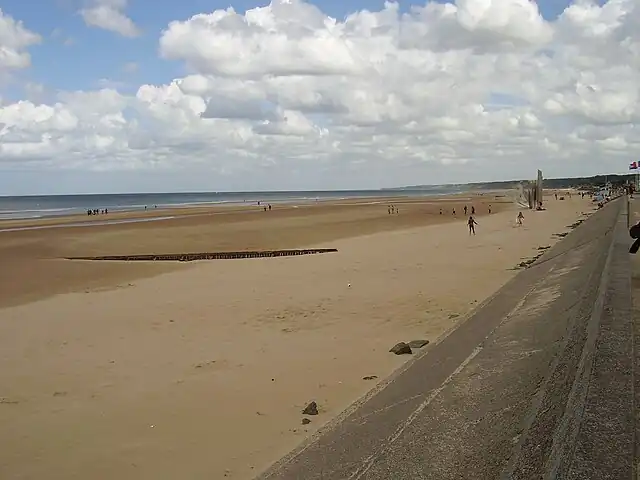
Despite urgent Soviet pleas to open up a "second front now", there was no ground fighting, except a few commando raids, in northwestern Europe from mid-1940 to mid-1944. From 1939, the British RAF bombed Germany extensively, and after the US joined the war in 1942, the labour was divided, with the USAF attacking by day and the RAF and other Commonwealth air forces at night. In some places, notably Hamburg and Dresden, the two groups bombed continually for several days and created a firestorm (flames rising almost 500m and at ground level hot enough to melt glass) that almost completely destroyed the cities. After the war, there was some rather harsh criticism of Bomber Command's Sir Arthur Harris, and of Churchill, for these raids, but others argued they were necessary and justified.
Then, in June 1944, the Western Allies made the largest seaborne invasion in history, departing from the United Kingdom and landing in the French region of Normandy; see D-Day beaches. The Germans were already losing to the Soviets on the Eastern Front and being heavily bombed. From D-Day onward, they also lost ground in the north-west.

Soviet forces reached Berlin on 16 April 1945, beginning the Battle of Berlin which lasted until the entire city fell under Soviet control on 2 May. Hitler would commit suicide in Berlin on 30 April 1945. The war in Europe ended with the unconditional surrender of Germany on 7 May 1945.
Starting well before the outbreak of war, and continuing until the German surrender, the Nazis carried out the Holocaust, a campaign to exterminate Jews, Slavs and other perceived inferior races and enemies of the Nazi regime. Many people, particularly from the Baltic States, Ukraine, Belarus, Slovakia and Croatia collaborated with the Nazis for various reasons including virulent anti-Semitism and resentment towards Russians stemming from over a century of Imperial Russian and Soviet domination.
Aftermath
Subsequently, some German political and military leaders were indicted for war crimes in the Nuremberg trials; many got prison sentences and some were executed. However, some high ranking Nazis had escaped during the last days of the war or successfully hid from the Allies while others committed suicide, including Hitler himself, Himmler and Göring. Other Nazis were acquitted, sentenced to prison terms or never put on trial in the first place, and some war criminals got only nominal sentences. Some former Nazis later had successful careers in the German military, government, civil service or courts. While this happened in both German states, the East German Stasi which had partial access to Soviet and German wartime archives deliberately leaked compromising information about the Nazi-era crimes of high ranking German politicians for propaganda purposes. The German-speaking minorities in neighboring countries such as Poland, Czechoslovakia, Hungary, Romania, the Netherlands and the Soviet Union were viewed with suspicion by locals following the Nazi occupation, in part due to the high level of support for the Nazi regime among them. Subsequently, many were expelled to Germany in the years immediately after the war. The expelled refugees were integrated into German society but many formed a revanchist and politically right wing faction often led by old Nazis. Refugees turning away from the Social Democrats over Willy Brandt's policy of rapprochement and acknowledgement of the Oder Neiße Boundary led to a vote of no confidence and snap elections in 1972.
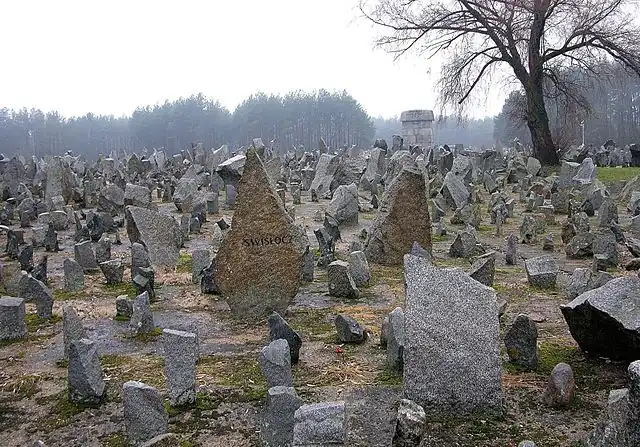
During the war, Nazi Germany and other Axis nations conducted a campaign of internment, forced labour, inhuman types of experimentation on captive human subjects that usually ended in their murder, and outright mass murders, today known as the Holocaust. Concentration camps and other remnants from these crimes against humanity are described in the article about Holocaust remembrance. As the Western Allies were fearful of the data ending up in the hands of the Soviet Union, many of the Nazi scientists who conducted the human experimentation were granted immunity from prosecution and resettled in the United States, where many would end up having successful careers in industry and academia.
The demographics of Europe would be permanently changed after the war, as most of Europe's Jews were killed by the Nazis, while most of the survivors would flee Europe for Israel or the United States in the years following the war. Today, the only Jewish communities that remain in significant numbers from the pre-War years are the ones in Russia and the United Kingdom that managed to avoid Nazi occupation. However, the start of the Arab-Israeli conflict and resulting anti-Jewish purges would lead to a large exodus of Jews from Muslim countries, with many of those from France's former North African colonies of Tunisia, Algeria and Morocco settling in France and re-establishing the Jewish community there. Germany meanwhile once again has a Jewish community, in part growing through immigration from the former Soviet Union or even Israel since the 1990s.
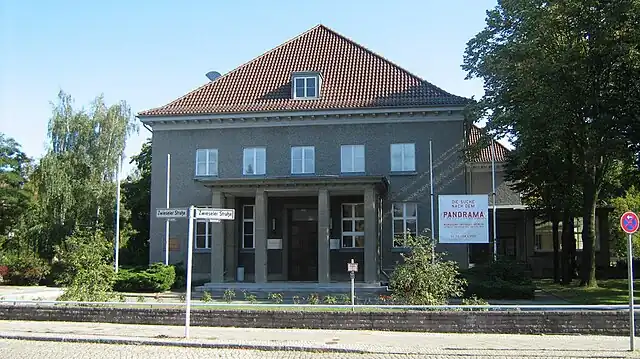
Germany itself would be split into four occupation zones, which were occupied by the United States, the United Kingdom, France and the Soviet Union respectively, with the city of Berlin, located entirely within the Soviet zone, also being split among similar lines. The American, British and French zones were gradually merged to form capitalist West Germany from 1946 to 1949, while the Soviet zone became communist East Germany. West Berlin became a de facto exclave of West Germany despite being located entirely within the Soviet zone, and the Berlin Wall was built to keep East Germans from defecting to the West via West Berlin. This would last until 1990, when the communist regime in East Germany fell, and Germany would once again be reunited as a single nation. Austria was likewise partitioned into four zones of occupation with Vienna also being split, but Nazi-era annexations of surrounding suburbs being undone. However, by 1955 Austria had convinced the Soviets and the Western Allies to withdraw their occupation forces in exchange for a promise of perpetual neutrality and not to form any kind of union with Germany. Vienna subsequently became the headquarters of many international organisations and a city of spies, but many high-ranking Austrian Nazis escaped prosecution.
Most casualties of the war and its aftermath were young men. This caused a deficit of males, which has persisted until the early 21st century in the former Soviet Union. While birth rates were suppressed during the war, the numerous generation born in the late 1940s became known as the Baby boomers, who came to be a dominant generation in the 1960s and 70s counterculture. The 1960s decline in birth rates often ascribed to the effect of modern contraception and changing attitudes towards sexuality was also exacerbated by the potential parents never being born during the war.
In the following decades, Europe was divided between two power blocs in a latent conflict known as the Cold War, which ended through the Eastern European revolutions in the late 1980s and early 90s.
Legacy
Wars have usually pioneered the usage of mass media; the printing press in the Thirty Years War, telegraphy and photography in the American Civil War, and radio in World War I. World War II was the war of motion pictures, and while film had existed since the turn of the century, it came to be used on a scale never seen before, for newsreels, propaganda, entertainment and education, using new technologies such as sound, colour, incidental music, animation, and even television. The motion picture archives from the war are enormous, and some war movies including documentaries are fantastic epics, though the selection is uneven and biased. A lot of the German movie production during the Nazi era served propaganda purposes of some kind but most of it was (at least on the surface) escapist entertainment, still with very few exceptions, movies from that era are rarely screened in Germany and if they are, there is often an introduction that explains the historical context. Meanwhile Allied movies of the era - even those that were war propaganda - are still appreciated for their artistic merit, including in the former Axis countries.
The war has also been the background of too many books, documentaries and historical dramas to make a representative selection.
As a result of the war, the swastika has become inextricably linked with Nazism and anti-Jewish hatred in Europe and the Americas, to the point that its historic use in much of the world as an ancient symbol of divinity, well-being and prosperity is now largely forgotten, except in Asia, where it continues to have positive connotations among Buddhists, Hindus, and Jains.
Sites
| “ | We shall fight in France, we shall fight on the seas and oceans, we shall fight with growing confidence and growing strength in the air, we shall defend our island, whatever the cost may be. We shall fight on the beaches, we shall fight on the landing grounds, we shall fight in the fields and in the streets, we shall fight in the hills; we shall never surrender. | ” |
—UK Prime Minister Winston Churchill, 4 June 1940 | ||
There are minor monuments, and exhibits in local museums, all over Europe and North Africa; those may be well worth looking for. This section makes no claim to being comprehensive; we just try to list some of the more important ones.
Belarus
- 🌍 Khatyn Massacre site, Minsk Oblast, Belarus. The site of the former village of Khatyn, which was completely razed to the ground by the invading Germans, who also massacred nearly all the villagers, leaving only six survivors. Today, the site is home to a memorial to the victims of the massacre.
- 🌍 Naliboki Forest, Nalibaki, Belarus. The old-growth forest complex, situated on the right bank of the Neman river, was a camp site called "Jerusalem in the Woods", where Tuvia Bielski and his Jewish brothers, built a community as a hideout for partisan fighters in saving 1,200 Jews who survived the Holocaust.
Belgium
- 🌍 Fort Eben-Emael (close to Maastricht). A Belgian "impregnable" World War II fort. The fort was assaulted by German airborne troops on 10 May 1940, forcing the defenders to surrender and thus allowing the Germans to bypass Belgian defensive positions. It is no longer in use, but open to the public on certain weekends.
- 🌍 World War II Ardennes American Cemetery and Memorial (Neupré). This memorial commemorates the American soldiers who died in northern Europe during World War II. The chapel contains maps and relief sculptures depicting the campaigns in the region. Free. (updated Mar 2015)
- 🌍 World War II Henri-Chapelle American Cemetery and Memorial (Henri-Chapelle). The cemetery is the final resting place for 7,987 American military dead lost during the drive into Germany, many in the Battle of the Bulge. A monument is inscribed with the names of 450 Americans whose remains were never found or identified. A museum and a chapel are located on the grounds. Free. (updated Dec 2022)
Canada
Although no fighting took place on Canadian soil, Canada took an active part in the war. The Canadian navy and merchant marine were important in the Battle of the Atlantic, while their air and ground forces fought primarily in the European theatre. In the D-Day landings, one of the five beaches was Canadian. World War II was the most recent conflict in which Canada had active conscription.
- 🌍 Canadian War Museum, Ottawa. Canada's main military history museum, with displays commemorating the efforts of Canadian troops in various wars and peacekeeping missions, including both world wars. (updated Aug 2021)
- 🌍 Canadian Aviation and Space Museum, Ottawa. This museum includes planes from both world wars. During WW II, many of Britain's planes were built in Canada.
- 🌍 Camp X (Intrepid Park) (near Oshawa). This was a secret training school for spies and saboteurs. It trained people for many European resistance movements, and trained agents for the American OSS which later developed into the CIA. It is now called "Intrepid Park" after Sir William Stephenson, a Canadian who headed British Intelligence in the western hemisphere and was codenamed Intrepid. Today the buildings are gone but there is a monument.
Two Canadian towns — Gander, Newfoundland and Goose Bay, Labrador — originated as refuelling stops for transatlantic flights in the days when planes did not have the range for non-stop flights, and both were important during the war for delivering aircraft from American and Canadian factories to Europe. Today they are just small towns with remarkably large airports; both are still RCAF air bases. Gander was a base for anti-submarine patrols as well as a fuel stop and has memorials both for WW II casualties and for several hundred American servicemen killed when their plane crashed on takeoff in 1985.
Czech Republic
With the emerging danger of Nazi Germany, Czechoslovakia built a system of border fortification between 1935 and 1938. As a result of 1938 Munich treaty, the army gave up the resistance efforts and abandoned the defence line. The fortification system is mostly well preserved and can be toured in several locations.
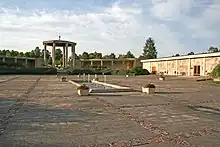
- 🌍 Hanička artillery fortress (Tvrz Hanička) (East Bohemia), tvrzhanicka@seznam.cz. In the 1970s, Hanička was intended to be rebuilt into a nuclear bunker and the construction works lasted until 1993, but they were never completed. You can take a guided tour through some of the objects. The Educational Trail "Fortification of Rokytnice and surroundings" runs through the museum area and provides information about the fortifications and their history in Czech, Polish and English. (updated Jun 2015)
- In 1942, the villages of Lidice and Ležáky were destroyed by Nazi German forces in a brutal retaliation for the assassination of Reinhard Heydrich, the acting Reichsprotektor of the Protectorate. Inhabitants were massacred; men were shot, women taken to concentration camps or killed and children gassed or given over to German families for Germanisation. The memorials of the civilian victims tell the story of these war crimes.
- 🌍 Lidice memorial (Prague-West District). (updated Jun 2015)
- 🌍 Ležáky memorial (near Pardubice). (updated Jun 2015)
France
These are listed in chronological order:
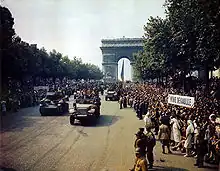
- 🌍 Dunkirk. A coastal French town in the Pas de Calais region. As the Germans overran France in 1940 a large Allied force, mostly British but including Canadian, Belgian and French troops, were surrounded in the Dunkirk region. Over 300,000 men were evacuated to Britain, many by volunteers using everything from fishing boats to pleasure craft, despite strenuous German efforts to prevent evacuation. Part of the local town cemetery is reserved for the graves of Commonwealth soldiers who fell in the battle, and there is a monument in that section of the cemetery of the town that commemorates 4,000 Commonwealth troops who fell in the battle but have no known grave.
- 🌍 Dieppe. A coastal town that was the target of a large — over 6,000 men, mostly Canadian — commando raid in 1942.
- 🌍 Saint-Nazaire (Pays de la Loire). This coastal town at the mouth of the Loire has the only dry dock on the French Atlantic coast large enough for battleships. The British destroyed it in 1942 by ramming it with an old destroyer packed full of explosives.
- 🌍 D-Day beaches (Normandy). D-Day was June 6, 1944, the date of a massive Allied amphibious landing on the beaches of Normandy, also called Operation Overlord. It can be seen as the decisive point of no return for the war, though by that point the war was already lost for the Axis on the Eastern Front, and in the West they had already lost North Africa and Italy. The massive German defenses were overcome by the smart planning, manpower and technology of the Allies, and less than a year later Germany surrendered. American general Dwight D. Eisenhower made his name as the main planner behind the D-Day invasions, which would eventually propel him to the presidency in the 1952 election. The article covers not only the invasion itself but also the whole campaign in Normandy which lasted into August.
- 🌍 Falaise (Normandy). Center of a major battle shortly after D-Day where the Allied forces cut off the last escape route of an almost surrounded German force. Nowadays it is a restored town.
- 🌍 Neuville-au-Plain (Lower Normandy). In June 1944, a few days after the D-Day landings, Neuville became the scene of an ambush between German troops and elements of the 505th Infantry Regiment and 82nd Airborne Division. After capturing the commune, 42 men were left to defend it. The skirmish was the main subject for the 1998 film Saving Private Ryan.
- 🌍 Oradour-sur-Glane. A French village razed and burned by the Germans in 1944, a few days after D-Day, with its civilian population murdered to avenge the resistance. Now a ghost town.
Germany
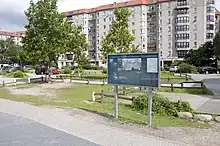
As Hitler fought the war to the bitter end (fighting on, long after any chance at military victory was gone) and military innovations (notably bomber aircraft) made this war far more destructive than the one before it, especially for Germany, hardly any place important during the Nazi era was left untouched by the war.
- Several old towns were severely bombed and in some places there are still monuments reminding of that as well as "mountains" made up of debris.
- 🌍 Berlin. The capital of Germany, captured by the Red Army in April, 1945. There is the Topographie des Terrors that explains which Nazi office sat where and played which role in the war and criminal machinery. To prevent it from becoming a shrine to Nazism, the post-war German government sealed off the entrances to the Führerbunker and demolished all its above-ground structures; all that remains is an empty field and a sign describing the history of the site.
- 🌍 Heligoland. This island still sees the scars of one of the biggest non-nuclear explosions to date. This happened shortly after the war: the British tried to blow up the island, which was used as a military installation during the war. Several other East Frisian islands and North Frisian islands were also used militarily by the Nazis.
- 🌍 Nuremberg. Known for the Nazi party rallies. After the war, the Allies held the Nuremberg Trials of Nazi leaders here. The rallying grounds (now thankfully sans Swastikas) have partially been turned into a museum but the complex is so huge that it is also used for numerous other purposes, including - perhaps ironically - American Football matches and rock concerts. A Burger King branch also sits in a building built for some purpose during the rally ground era.
- 🌍 Peenemünde. The site where Wernher von Braun (later an important figure at NASA) and his scientists developed and constructed the first V-2 (Agregat 4) rockets (one of them is on display at the Deutsches Museum in Munich) to be shot at London and later Antwerp.
- In the waning years of the war many "war important" industries were relocated underground. One of the most infamous is the forced labour camp Dora Mittelbau near Nordhausen where the V-2 rockets were built. The site has been turned into a museum that show the horrific conditions (more people died in constructing the rockets than in their actual use).
Italy
- 🌍 Anzio Beachhead Museum, Anzio. In the same building is the Archaeological Museum.
- 🌍 Monte Cassino War Graves. The Commonwealth War Graves cemetery is a beautifully maintained area with magnificent views of the Monte Cassino monastery. The French and Italian cemeteries are on Highway 6 in the Liri Valley. There is a very striking Polish cemetery close to the battlefield and easily visible from the monastery. The German cemetery is approximately 2 miles (3 km) north of Cassino in the Rapido Valley. American casualties are not buried here but at Nettuno-Anzio. (updated Jul 2017)
Netherlands
- Rotterdam was bombed by Germany even after the surrender of the Dutch government.
- 🌍 Anne Frank House (Anne Frankhuis) (Amsterdam). The house where the Jewish girl Anne Frank wrote her diary while hiding with her family from the Nazis.
- 🌍 Walcheren Causeway (Walcheren). A narrow causeway that was the only land connected between Walcheren and South Beveland and consisted a dike surrounded by tidal mudflats. However, in late 1944, it became the scene of a three-day battle when Canadian forces assaulted the causeway in order to establish a foothold on German coastal defences.
Poland
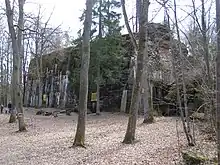
Poland saw a disproportionally high number of civilian deaths mainly because it was invaded by both the Soviets and the Germans in the early stage of the war with both trying to "remodel" their part of the country according to their wishes, which in practice meant killing members of all groups that could potentially resist the occupation such as intellectuals, politicians, Catholic priests and high-ranking military. As Poland had a big and thriving Jewish community it was also hit particularly hard by the Shoah, with Poles both aiding the Nazi crimes and helping Jews escape. Poland was the only country where aiding Jews was explicitly punished by death and the Polish underground responded by making the betrayal of Jews also punishable by death. See Holocaust remembrance#Poland.
- 🌍 Auschwitz-Birkenau (at Oświęcim, 60 km west of Kraków.). The largest and most infamous Nazi concentration camp, and a UNESCO World Heritage Site. Contained both a labour camp section and an extermination camp. More than a million prisoners died here before it was liberated by the Soviets in January 1945.
- 🌍 Gdansk. The war began with a dispute over Gdansk (German name: Danzig), that was deliberately escalated by Hitler. Gdánsk was at the time a "free city", independent of both Poland and Germany, and had many German-speaking residents, but the proposed construction of an autobahn from Germany to Gdansk/Danzig would have clearly encroached upon sovereign Polish territory. Poland was an ally of the United Kingdom, seat of a mighty empire, and this alliance would bring the British Commonwealth nations to war. Gdansk is now part of Poland and was the birthplace of the Solidarność trade union movement during the Cold War. The city has a modern and impressive Museum of the Second World War. (updated Aug 2019)
- 🌍 The Wolf's Lair (German: Wolfsschanze) near Kętrzyn (German: Rastenburg) was the German military headquarters where Hitler resided during most of World War II. It was here that the failed attempt to kill Hitler took place on July 20, 1944.
- 🌍 Soviet Military Cemetery, Warsaw, Warsaw. Burial site of over 21,000 Soviet soldiers who died fighting the Germans.
In the Volhynia Massacre, which occurred on what is today the border area between Ukraine and Poland from 1943-1945, up to 100,000 ethnic Poles were massacred by Ukrainian nationalists, and this incident continues to be a major bone of contention in the otherwise friendly diplomatic relations between Ukraine and Poland.
Russia
The Soviet Union and Nazi Germany signed the Molotov–Ribbentrop Pact in 1939 and were guardedly friendly for some years; the Soviet Union even took a chunk of Poland, with German permission, in September 1939. However Germany broke the pact by invading the Soviet Union on 22 June 1941 (Operation Barbarossa).
The Russian name for World War II translates as the Great Patriotic War. The Soviet Union bore the brunt of the fighting and had more dead (both civilian and military) in this war than any other country; only China was even close.
The Nazis considered Slavs an inferior race and fought a war of extermination on the Eastern Front in order to have them make way for Lebensraum (living space) for the "Aryan race" (i.e. ethnic Germans). When forced to retreat, as they often were at first, the Soviets used a "scorched earth" policy, burning crops in the fields and destroying everything else that might be useful to the enemy. Although the Germans made quick territorial gains in the initial stages of the war, the German soldiers were not prepared for the brutality of the Russian winters, and the Soviets were able to use this to their advantage and counterattack.
POWs of both sides were mistreated horribly on the Eastern Front and sometimes the surviving Soviet POWs were regarded as "traitors", as having survived the inhumane conditions without "treason" was deemed impossible. A large number of Soviet citizens, especially those from Ukraine, the Baltic States and Belarus, collaborated with the Nazis, for several reasons, including as a way of avoiding the high probability of death as Soviet POWs, hostility to the Soviet Union or Russians, and virulent antisemitism. Some of the SS "volunteers" among the Soviet POWs were used to shoot Jews and serve as guards in extermination camps.
Every year, on 9 May, major Russian cities hold an Immortal Regiment march as part of their Victory Day celebrations, in which locals march down the street holding up pictures of people who fought in the war.
- 🌍 Museum of the Great Patriotic War (Moscow). Russia's main museum dedicated to the Soviet war effort, also with exhibits commemorating the civilian victims of the war.
- 🌍 Stalingrad (Volgograd). This city, now called Volgograd, was the scene of one of the longest (almost six months) and bloodiest (around two million total casualties) battles in history. The Russians had 478,000 killed or missing in this one battle, more than the UK or US lost in the entire war. The city was then, as it is now, an important transport hub and regional centre. The almost utter annihilation of the German forces in the area was the definitive turning point on the Eastern Front. In Russia and in Germany the battle is shrouded in myth and for the 70th anniversary of the battle in 2013, local authorities renamed the city to Stalingrad for one day. Today, you can see the ruins of an old mill that was destroyed in the battle, which has been preserved in its ruined state as a reminder of the ferocity of the battle. There is also a famous colossal statue known as The Motherland Calls, which was built in honor of the victims and casualties of the battle, with the graves of numerous soldiers who fell in the battle located just behind the monument.
- 🌍 Kursk. The largest tank battle in history — 6,000 tanks, 4,000 aircraft and about two million troops — was fought near this city in July 1943 as the Red Army began to roll west after Stalingrad and the Germans tried unsuccessfully to stop them. Casualties were heavy on both sides. The town has a museum for that battle and there is a memorial on the battlefield itself. Arguably the war was over for Germany when this battle was lost; the Soviet forces kept the initiative all the way to Berlin and the Germans never again came so close to stopping them.
- Prokhorovka. En route to Kursk, the Red Army won a battle near this town. There is a memorial in the city's cathedral.
- 🌍 Leningrad (Saint Petersburg). One of the most beautiful cities in Russia, the seat of power of the Tsars in imperial times, called Saint Petersburg in Tsarist times and again since 1991. During the war, the city was known as Leningrad, and was site of the Siege of Leningrad (8 September 1941–27 January 1944), which was one of the longest sieges in history, resulting in countless deaths, both civilian and military, primarily through starvation. Though the Soviets eventually succeeded in driving the Germans back, many historical artifacts were looted or destroyed by the Germans as they retreated. Today, there is the 🌍 Piskaryovskoye Memorial Cemetery, in which almost 500,000 victims of the Siege of Leningrad, most of them civilians, were buried.
- 🌍 Road of Life (Доро́га жи́зни Doroga zhizni). This route, crossing Lake Ladoga on an ice road, was the only lifeline of the residents of Leningrad/St Petersburg trapped in their city during the Siege of Leningrad. Continuing east from the city past Vsevolozhsk, it arrived in the village of Kokkorevo on the western side of Lake Ladoga. Here, the ice road began on the southern arm of the lake. The ice was thick enough as to allow even mass transit of supplies, but the high winds that blew out of the open vastness of the lake (the largest in Europe) were a problem. A driver testified "we would drive with the door open, ready to jump...we lost some trucks". The ice road made its landfall in the village of Kobona on the eastern bank of the lake and continued on to the Voibokalo train station before connecting with the national rail network there. Along the entire length of the Road of Life on solid ground, as well as other nearby areas, numerous monuments commemorate the route, including the 🌍 Broken Circle (Разорванное кольцо Razorvannoe kol'tso) on the 40th kilometre of the road, right on the bank of the lake near Kokkorevo.
Georgy Zhukov, the Soviet general who commanded at both Stalingrad and Kursk, also has a museum near the site of his first major victory, trouncing the Japanese in the 1939 Battle of Khalkhin Gol in Mongolia.
Crimea
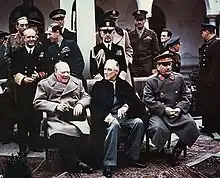
- 🌍 Livadia Palace (Crimea). The summer retreat of the Tsars, in Yalta, this is where the famous Yalta Conference took place from February 4 to 11, 1945 in which Soviet leader Joseph Stalin, American President Franklin D. Roosevelt, and British Prime Minister Winston Churchill met to discuss how they wanted to rebuild and reform Europe after the war. Roosevelt stayed in the palace during the conference period.
Nordic countries
Sweden was non-belligerent (no proclamation of neutrality was made) throughout the war, while Norway and Denmark were both occupied by Germany despite the attempts of their governments to remain neutral. Even so, all three countries prepared for war and thus a number of bunkers still exist in all three countries. Most of them were built after the Nazis took over Norway and many never saw a shot fired in anger, but their presence even in remote areas is somewhat eerie. Routes used by refugees from Norway, and by the Norwegian resistance, can be experienced on a hike.
Finland, on the other hand, was directly involved in the Second World War, fighting three separate campaigns. In 1939 the Soviet Union attacked Finland in the Winter War. Finland succeeded in taking advantage of the exceptionally severe winter, destroying troops caught on the few and narrow roads in sparsely populated regions with "motti" tactics. In the peace treaty Finland still lost territory, including Vyborg, then one of the most important cities of Finland. When Germany launched Operation Barbarossa, Finland saw its chance to regain the lost land – and to conquer Karelia, a controversial dream of many nationalists, excused as a way to get an easier-to-defend border – in the Continuation War. When the tide turned, Finland was overwhelmed, but succeeded to fight to enough of a standstill that peace could be negotiated. Finally, as stipulated in the peace agreement with the Soviet Union, the Lapland War was fought to expel the German troops from Lapland. In places like Hanko, Kymenlaakso, North Karelia and Lapland, you can still see fortifications and bunkers. Also on the coast there are stories to be told, and e.g. on Örö the coast artillery of the time is left to be visited. More can be seen on the Karelian Isthmus and in other regions that were part of Finland before WW2.
Iceland was invaded by the UK without mounting any resistance in 1940. The British transferred control of the island to the United States in July 1941, which violated American neutrality. Allied soldiers came to outnumber adult Icelandic men, establishing a strong Anglo-Saxon influence, with American fast food and arguably the highest proficiency in English in any non-Anglophone country. While Iceland had been a Danish dominion for centuries, the country voted to become independent in 1944. Today, steel hut barracks and other wartime installations remain spread around the island. Iceland's main international airport, Keflavík International Airport, was initially built as an American military airbase during the war.
- 🌍 Occupation Museum (Besættelsesmuseet) (Aarhus, Denmark). A small museum telling the story of local life under German occupation, located in the old town hall which was used by the Gestapo during the occupation.
- 🌍 Finnish Military Museum (Helsinki, Finland). Founded in 1929, the central museum of the Finnish Defence Forces.
- 🌍 Finnish air force museum (Tikkakoski, near Jyväskylä, Finland). Aircraft, engines and aircrew equipment used by the Finnish Air Force. Large collection of scale models, photos etc. Messerschmitt Bf 109 simulator (book in advance).
- 🌍 Järämä Sturmbock-Stellung (near Karesuvanto, Finland). Partly restored massive German fortification, part of Operation Birke during the Lapland War, to secure access to the Petsamo nickel, protect the harbours of the Arctic Ocean and protect an evacuation route. Museum and café.
During World War II, Mikkeli was the headquarters of the Finnish Army, and quite a few sights from the period remain.
- 🌍 Jalkaväkimuseo (Infantry museum). War museum, exhibitions depicting Finnish infantry from the independence to today.
- 🌍 Päämajamuseo (Headquarters museum). Mannerheim's headquarters during World War II. (updated Jun 2017)
- 🌍 Viestikeskus Lokki (Communications Centre Lokki). Mannerheim's headquarters' communications centre.
- 🌍 Joensuu Bunker Museum (Joensuun bunkkerimuseo) (Joensuu, Finland). As part of the Salpa-line protecting Finland from the threat of Russia during World War II, the museum displays several models of concrete bunkers fully equipped with original guns and gear. A bizarre but worthwhile visit. During summer some local history students will hang around geared up as soldiers serving tea and are willing to answer all your questions. Open only during the summer.
- 🌍 Virolahti Bunker Museum (Virolahti, Kymenlaakso, Finland), ☏ +358 40-585-0166, anu.haapala@miehikkala.fi. The exhibition is located inside a wooden building built to resemble the style of the war period in Finland. Outdoor part surrounding the museum building includes fortification sites in the forest. Fireplace is nearby.
- 🌍 Salpa Line Museum (Miehikkälä, Kymenlaakso, Southern Finland). Indoor exposition and an extensive outdoor exposition (guided tour included in the entrance fee, as well as a short film). Cafeteria and a museum store. Fireplace & BBQ grounds behind the museum.
- 🌍 Rjukan (Telemark, Norway). A hydroelectric power plant where the Germans tried to extract heavy water for their nuclear programme. A British-Norwegian commando team managed to destroy the facility.
- 🌍 Hegra festning (Hegra fortress) (Trøndelag, Norway). The only Norwegian fortress to be manned during the German invasion. As it was built to defend against an attack from Sweden, it had limited strategic importance, but resisted a few German attacks. The garrison surrendered on 5 May, 1940.
- 🌍 War Memorial Museum (Nordland Røde Kors Krigsminnemuseum) (Narvik, Sweden). Exhibitions about the Narvik Campaign in the Second World War. The Iron Ore Line from Sweden was important for the German war effort.
- 🌍 Beredskapsmuseet (The Military Readiness Museum in Sweden) (Helsingborg, Sweden). A museum of Sweden's preparation for the war that never came.
- 🌍 Grimeton Radio Station (Varberg, Sweden). The only remaining radio station of the 1920s long wave network is on the UNESCO World Heritage List. During summer months it is possible to visit the site at Grimeton, with the machine transmitter used for VLF transmissions on 17.2 kHz. It is the only workable machine transmitter in the world. During World War II, it was Sweden's only telecommunications link with the outer world.
Turkey
- 🌍 Çakmak Line (Çakmak Hattı). Named after Fevzi Çakmak, the Turkish Chief of General Staff at the time, this is a series of pillboxes and other fortifications littered across the Çatalca Peninsula between the coasts of the Sea of Marmara and the Black Sea, built as the last defence line of Istanbul from the west. Other collections of similar structures from the period exist in the isthmus connecting the Gallipoli Peninsula to the mainland (particularly around Bolayır), and other locations deemed strategically important elsewhere in Turkish Thrace, the European part of the country.
- 🌍 Yenice Railway Station (Yenice Garı) (east of Tarsus on the Mersin–Adana commuter line). While Turkey was neutral throughout most of the war, none of its neighbours were, and there was pressure from both camps to join in the fight with them. In 1943, Winston Churchill and Turkish president İsmet İnönü secretly met in a railcar in the unlikely location of the train station of Yenice, a small town in southern Turkey (selected as a compromise between the suggested conference sites of Cyprus, then ruled by Britain, and Ankara, the Turkish capital) to discuss the Turkish entry to the war on the Allied side (Turkey formally joined the Allies only in the final days of the war, in 1945). The event is commemorated by a large sign on the façade of the station building, and the railcar in which the meeting took place, colloquially known as the Beyaz Vagon ("white car") has been renovated and parked in the siding of a major rail junction just to the west of the station. (updated Jan 2018)
United Kingdom
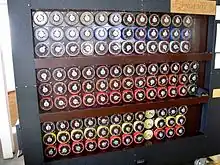
During the first years of the war, cities like London and Coventry were heavily bombed, though the British were successful in repelling the Germans and avoided occupation except for the Channel Islands. In the waning years of the war, the Germans shot V-1 (a crude version of a cruise missile) and V-2 (the first ballistic missile ever to be used in war) on south-east England in a last-ditch effort to turn the tide, but missed more often than actually hitting anything. Britain's superiority in military intelligence played a role in this - when V2s hit, British news reports would often indicate they had either over- or undershot their intended target (e.g. instead of hitting central London, they'd supposedly hit a field 20 miles due north or something similar) and the Nazis would "correct" the course into hitting empty fields for real. Furthermore, sabotage was a common problem in V2 production as they were made by forced laborers who were literally worked to death and thus had every motivation of harming the Nazi war effort.
- 🌍 Imperial War Museum, London. Britain's main military history museum, primarily dedicated to both world wars.
- 🌍 The Tank Museum, Bovington. One of the world's largest museums covering tanks and armoured vehicles. The museum also conducts a Tanks in Action display with explosions and a mock battle.
- 🌍 Bletchley Park, Milton Keynes. Central site of the British project codenamed "Ultra" which broke many German and Italian codes throughout the war and, along with the American "Magic" penetration of Japanese codes, provided much critical intelligence to Allied commanders. British counterintelligence was particularly effective with every German agent who tried to spy on Britain eventually either captured, killed or "turned" - in many cases without the Nazis ever being any the wiser.
- 🌍 Churchill War Rooms, London. Location of a secret government bunker used during the war, only about 150m from Number 10 Downing Street, which provided a meeting place for military and government officials. (updated Feb 2017)
- 🌍 St Martin's Church, Bladon. Church where wartime prime minister Sir Winston Churchill was buried. Churchill is the last non-monarch to have been granted a British state funeral. (updated Apr 2019)
- 🌍 HMS Belfast, London. British light cruiser that participated in the D-Day invasions. It has now been converted to a museum ship and is now permanently docked on the River Thames. (updated Jul 2021)
- 🌍 Battle of Britain Bunker, London, bunker@hillingdon.gov.uk. Bunker used at the former RAF Uxbridge during World War II to co-ordinate the No. 11 Group Fighter Command during the Battle of Britain. (updated Mar 2022)
United States
While no fighting occurred in the contiguous United States, several American ships, including civilian ones, were sunk by German submarines off the East Coast even before the United States entered the war. The United States would only formally enter the war on 8 December 1941, after the Japanese attacks on Pearl Harbor the day before.
- 🌍 The National WWII Museum (New Orleans), ☏ +1 504 528 1944. Museum commemorating the American war effort in both theatres of World War II, with interactive displays that aim to re-create the battlefield experience for visitors.
- 🌍 United States Holocaust Memorial Museum (Washington, D.C.). Museum dedicated to the memory of the victims of the Holocaust, built in consultation with Holocaust survivors who had emigrated to the United States after the war.
- 🌍 Dwight D. Eisenhower Presidential Library, Museum & Boyhood Home (Abilene, Kansas). Library and museum dedicated to Dwight D. Eisenhower, who made his name as Supreme Commander of the Allied Forces in the European theatre, eventually propelling him to the presidency in 1953. A section of the museum is dedicated to Eisenhower's World War II exploits.
- 🌍 Arlington National Cemetery, Arlington, Virginia. The main military cemetery of the United States, home to the graves of numerous soldiers who died fighting in various wars including both world wars.
- Wright Museum of World War II (Wolfeboro, New Hampshire). The focus is on World War II, but there are also exhibits on World War I, the Korean War and the Vietnam War.
Western Balkans
World War II began in Yugoslavia in April 1941 when the country was occupied by Nazi Germany and Fascist Italy. The resistance movement, known as the Partisans and led by Josip Broz Tito, fought a guerrilla liberation war against the occupying forces and their puppet regimes. With help from Britain, the United States and the Soviet Union, the Partisans emerged victorious in Yugoslavia, and a federal socialist republic with Tito as leader was formed after the war. There were also other groups, including Yugoslav monarchists who tried to re-establish the interwar Yugoslav monarchy and even some who fought to annex parts of Yugoslavia to Italy. On the whole the anti-Nazi partisan movement in Yugoslavia was the largest in Europe.
Numerous memorials to fallen Partisan fighters and victims of atrocities committed by Axis forces can be found throughout the region.
- 🌍 Šumarice Memorial Park (Kragujevac, Serbia). Memorial in central Serbia near the place where 2,800 local people, including children, were massacred by Nazi German occupying forces as retaliation for a Partisan attack. (updated Mar 2019)
- 🌍 Sutjeska National Park (near Foča, Bosnia and Herzegovina). A mountainous area in southeastern Bosnia known for being the site of a major World War II battle. At Sutjeska in June 1943, the Partisans repelled a German offensive, and despite casualties turned the tide of the war in their favour. (updated Mar 2019)
- 🌍 Jasenovac (near Sisak, Central Croatia). Known as Auschwitz of the Balkans, an extermination camp operated by the Ustaše regime ("Independent State of Croatia", a puppet of Nazi Germany). Many Jews, Serbs, Roma and anti-fascist Croats were murdered here. This may have contributed to the ethnic violence of the Yugoslav wars of the 1990s. (updated Dec 2022)
Respect
Some SS units are regularly commemorated in the Baltic states, Ukraine and by the Belarusian diaspora. Although controversial due to their Nazi links, their role in resisting Soviet domination is generally seen as more important.